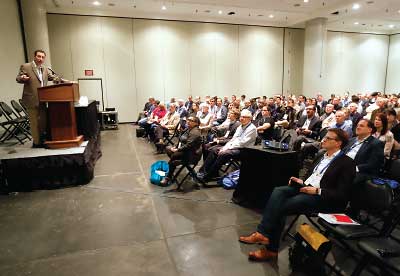Amit Etkin, M.D., Ph.D., sees a gathering wave that will transform how mental illness is perceived, identified, treated, and monitored in the coming years.
“We are not there yet, but we are getting close to the inflection point for a circuits-based understanding of mental illness,” said Etkin at APA’s 2018 Annual Meeting in May. Etkin is an associate professor of psychiatry and behavioral sciences at Stanford University.
The transition from DSM-IV to DSM-5 was significant, but “we are still in the dark ages” of psychiatric diagnosis, he said. Both the DSM series and the National Institute of Mental Health’s Research Domain Criteria (RDoC) are constructed from the literature, observation, and consensus and assume that “if we build stronger correlations, we will find causation. But that is not so. We have to separate correlation from causation.”
Existing DSM definitions also create an unwarranted specificity, said Etkin. A way to better define and study illness is to anchor that understanding in a more objective, biological approach based on brain imaging technology rather than a catalogue of symptoms.
“We don’t know, based on most of our imaging signals, whether the stories we’re telling are internally consistent but based not at all on actual mechanisms, or whether they are reflective of causal mechanisms,” said Etkin. “For certain, some of them are, but we don’t know which of them are and which are not.”
Meta-analyses of imaging studies of emotional processing in thousands of patients with anxiety and depression indicate many commonalities—such as loss of gray matter in elements of the salience network—across existing, symptom-based diagnoses. The most pronounced divide revealed by imaging lies between psychotic and nonpsychotic patients.
“If you look at cognitive symptoms in depression, they don’t correlate at all with cognitive impairment measured objectively,” he said. Using an objective test based on brain signatures tied to behavior can separate patients impaired by their illness from those who may be equally symptomatic.
In other studies of patients with posttraumatic stress disorder (PTSD), Etkin has looked for patterns that might predict response to prolonged exposure therapy. Combining a visual memory recall task with functional MRI (fMRI) revealed that a greater response in the prefrontal brain region predicted better treatment outcomes, independent of symptoms, he said.
Next, he used a verbal memory test with two sets of patients with PTSD, each subdivided into impaired and intact groups. Connectivity in the salience network was similar in the intact patients and the healthy controls but significantly lower in patients impaired by PTSD, said Etkin.
However useful fMRI may be as a research tool, it is still too expensive for the clinic, he said. In contrast, electroencephalogram (EEG) machines are more common and more affordable and can be deployed at the point of care. Etkin discussed ways of using EEG with a protocol called “power envelope” to study connectivity in the visual, somatomotor, frontoparietal regions of the brain, as well as the default mode network. Within the next two to three years, he plans to recruit PTSD patients based on biology, not symptoms, and then assess them weekly to develop metrics on brain function.
Repetitive transcranial magnetic stimulation (rTMS) can stimulate specific areas of the brain-initiating signals that can be followed by fMRI or EEG to establish patterns of connectivity and quantify causal influences on the brain.
“This gives us the initial hope that by understanding and targeting specific circuitry in a more precise and causal manner, we can identify patients who cannot respond to specific interventions,” he said. “All of that assumes that you have a tool for getting to the right place, hitting the right target, and quantifying the changes you want to make.”
The move toward a circuits-based psychiatry may still be a work in progress, but progress is moving rapidly, he believes.
“We can transform psychiatry by identifying points of neural circuit dysfunction in individuals, then achieve optimized neural circuit plasticity, and use our toolbox to restore neural circuit function to improve behavioral symptoms,” he said. ■

